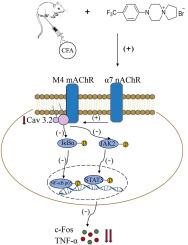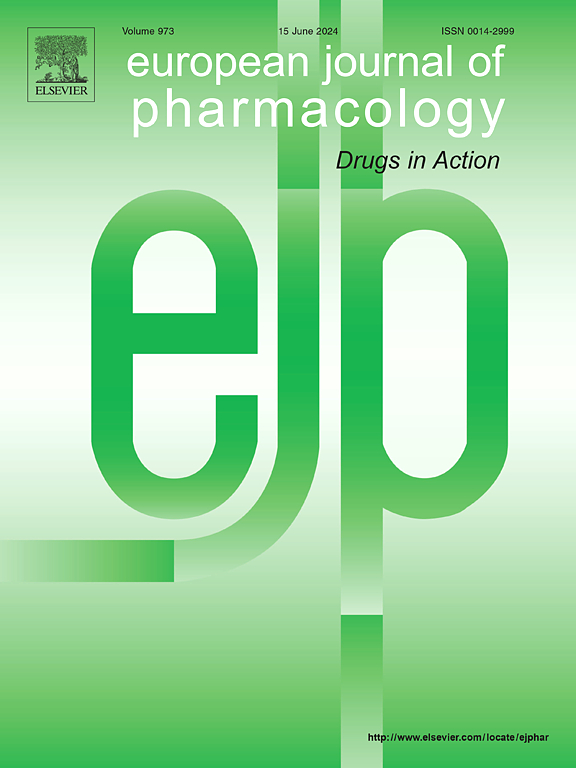螺环哌嗪溴化物 DXL-A-24 对 CFA 诱导的关节炎大鼠的抗关节炎作用及其机制
IF 4.2
3区 医学
Q1 PHARMACOLOGY & PHARMACY
引用次数: 0
摘要
本研究旨在探讨螺环哌嗪溴化物 DXL-A-24 对完全弗氏佐剂(CFA)诱导的大鼠关节炎的影响及其内在机制。通过向大鼠爪部皮内注射 CFA,建立了类风湿性关节炎模型。用机械退缩阈值(MWT)、热退缩潜伏期(TWL)、踝关节肿胀和爪水肿来评估 DXL-A-24 的作用。使用微型计算机断层扫描观察骨侵蚀和骨矿物质密度(BMD)。为探究其作用机制,还进行了受体阻断试验、Western 印迹和酶联免疫吸附试验。DXL-A-24(1、0.5、0.25 毫克/千克,静脉注射)剂量依赖性地增加了 CFA 大鼠的 MWT 和 TWL,同时缓解了脚踝和脚掌肿胀。外周α7烟碱或 M4毒蕈碱受体拮抗剂可阻断这些效应。DXL-A-24 改善了骨侵蚀和 BMD,并降低了 CFA 诱导的 Cav3.2、pJAK2、pSTAT3、pIκBα、pNF-κB p65、c-Fos 和 TNF-α 蛋白的过度表达。总之,本研究首次表明,DXL-A-24 可改善 CFA 大鼠的骨侵蚀和 BMD,并具有明显的抗关节炎作用。其机制可能与激活外周α7烟碱受体和M4毒蕈碱受体,降低Cav3.2表达,抑制JAK2/STAT3和IκBα/NF-κB p65炎症信号通路,最终抑制炎症相关蛋白TNF-α和c-Fos有关。本文章由计算机程序翻译,如有差异,请以英文原文为准。

Anti-arthritic effect of spirocyclopiperazinium bromide DXL-A-24 in CFA-induced arthritic rats and its mechanism
This study aimed to investigate the effect of spirocyclopiperazinium bromide DXL-A-24 on complete Freund's adjuvant (CFA)-induced arthritis and its underlying mechanism in rats. A rheumatoid arthritis model was established by the intradermal injection of CFA into the paws of rats. Mechanical withdrawal threshold (MWT), thermal withdrawal latency (TWL), ankle swelling and paw edema were used to evaluate the effects of DXL-A-24. Bone erosion and bone mineral density (BMD) were observed using micro-computed tomography. Receptor blocking test, western blotting, and enzyme-linked immunosorbent assay were performed to explore the mechanisms. Administration of DXL-A-24 (1, 0.5, 0.25 mg/kg, i.g.) dose-dependently increased the MWT and TWL, while alleviating ankle and paw swelling in CFA rats. The effects were blocked by peripheral α7 nicotinic or M4 muscarinic receptor antagonists. DXL-A-24 improved bone erosion and BMD, as well as downregulated the overexpression of Cav3.2, pJAK2, pSTAT3, pIκBα, pNF-κB p65, c-Fos and TNF-α proteins that were induced by CFA. In conclusion, this study shows, for the first time, that DXL-A-24 improves bone erosion and BMD and exhibits obvious anti-arthritic effects in CFA rats. The mechanism may be related to activating the peripheral α7 nicotinic and M4 muscarinic receptors, reducing Cav3.2 expression, and suppressing JAK2/STAT3 and IκBα/NF-κB p65 inflammatory signaling pathways, ultimately inhibiting inflammation-related proteins TNF-α and c-Fos.
求助全文
通过发布文献求助,成功后即可免费获取论文全文。
去求助
来源期刊
CiteScore
9.00
自引率
0.00%
发文量
572
审稿时长
34 days
期刊介绍:
The European Journal of Pharmacology publishes research papers covering all aspects of experimental pharmacology with focus on the mechanism of action of structurally identified compounds affecting biological systems.
The scope includes:
Behavioural pharmacology
Neuropharmacology and analgesia
Cardiovascular pharmacology
Pulmonary, gastrointestinal and urogenital pharmacology
Endocrine pharmacology
Immunopharmacology and inflammation
Molecular and cellular pharmacology
Regenerative pharmacology
Biologicals and biotherapeutics
Translational pharmacology
Nutriceutical pharmacology.

 求助内容:
求助内容: 应助结果提醒方式:
应助结果提醒方式:


